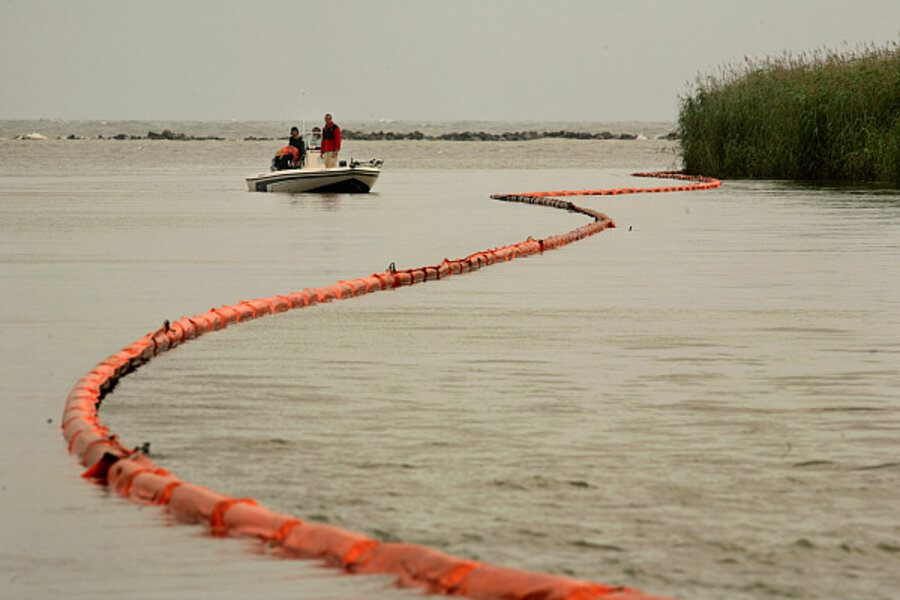C'mon, how big is the Gulf of Mexico oil spill, really?
Loading...
| Atlanta
Calculating the exact flow of crude out of the bent Deepwater Horizon oil rig "riser" pipe on the bottom of the Gulf of Mexico is difficult. But it's now likely that the actual amount of the oil spill dwarfs the Coast Guard's figure of 5,000 barrels, or 210,000 gallons, a day.
Independent scientists estimate that the renegade wellhead at the bottom of the Gulf could be spewing up to 25,000 barrels a day. If chokeholds on the riser pipe break down further, up to 50,000 barrels a day could be released, according to a National Oceanic and Atmospheric Administration memo obtained by the Mobile, Ala., Press-Register.
As estimates of the spill increase, questions about the government's honesty in assessing the spill are emerging. At the same time, pressure is building for the US to release worst-case scenario estimates so residents of the Gulf Coast can adequately prepare.
IN PICTURES: Louisiana oil spill
Meanwhile, BP is working furiously to do the unprecedented: Activate a faulty blowout preventer a mile under the Gulf to stop the leak at its source. If that fails, it could take three months, or more, to drill a relief well in order to plug the renegade well.
“In the environmental arena, risk modeling is done day-in and day-out for every type of pollutant, whether going in the water, earth or air," says Stuart Smith, an environmentl attorney in New Orleans, in a statement. "Why are BP and the Environmental Protection Agency not releasing such information to the public?
After originally saying the rig wasn't leaking at all, the Coast Guard originally used estimates in part provided by BP to describe the size of the spill as 1,000 barrels a day.
The Deepwater Horizon oil rig exploded on April 20, killing 11 and injuring 17 of a 126-member crew. It exploded again and sank 36 hours later. The resulting leak has created a Jamaica-sized oil slick that is now whirling in a hurricane shape into sensitive marshes of the Louisiana coastline, endangering birds, fish, oysters, and many peoples’ livelihoods.
President Obama prepared to visit the affected area this weekend as the government began wresting control of the relief operation from BP, which leased the Deepwater Horizon rig, and which has so far provided leak estimates based on reconnaisance of the crumpled pipe done by remote-controlled mini-subs on the murky bottom.
Officials say measuring the outflow is extremely difficult – like trying to gauge by eye the amount of water spurting from a leaky garden hose.
The Obama administration, which only a month ago proposed opening up new coastal areas for oil exploration, has put on hold all new exploratory drilling along the US continental shelf and is now fighting to stay ahead of what sociologist Steven Picou at the University of South Alabama calls a "monster catastrophe that boggles the mind."
A government report obtained by the Mobile, Ala., Press-Register explains that "choke points" in the crumpled riser are controlling the flow from the so-called Macondo well at Lease Block 252 in the Mississippi Canyon. But scrubbing action from sand in the oil is further eroding the pipe. There are likely tens of millions of gallons in the deposit that BP tapped with the Deepwater Horizon.
"The following is not public," reads National Oceanic and Atmospheric Administration's Emergency Response document dated April 28, according to the Press-Register. "Two additional release points were found today. If the riser pipe deteriorates further, the flow could become unchecked resulting in a release volume an order of magnitude higher than previously thought."
An order of magnitude is a factor of 10.
The Wall Street Journal reported Friday that John Amos, an oil industry consultant, said that NOAA revised its original estimate of 1,000 barrels after he published calculations based on satellite data that showed a larger flow.
The 5,000 barrels a day is the "extremely low end" of estimates, Mr. Amos told the Journal.
"There's a range of uncertainty, and it's very difficult to accurately gauge how much there is," BP spokesman John Curry told the Journal.
IN PICTURES: Louisiana oil spill
Related:
Experts: Most of Gulf of Mexico oil spill won't be cleaned up
With Katrina comparisons inevitable, Obama plans oil spill visit
The Monitor's View
Obama and offshore drilling: a crude move





